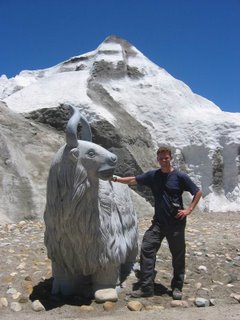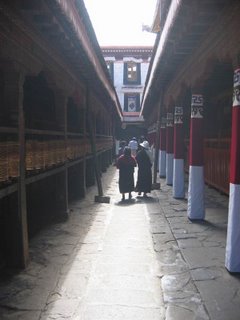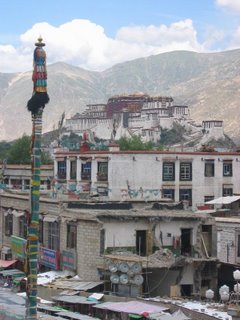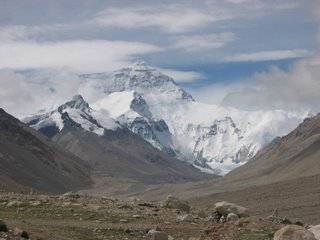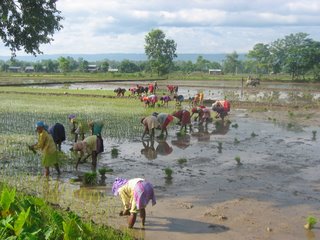Friday, July 28, 2006
Monday, July 17, 2006
Sunday, July 09, 2006
Our last stop in Nepal was the 'last resort'. 15 km from the Tibetan border in the beautiful country of the himalayan foothills it is famed for being the home of the third highest bungey jump in the world.
Well it had to be done, didn't it.
Bungey jumping is something that I have always said I would never do. My stock argument being that the cost/time ratio was too high, but in this location, at this cost and at this height it was too hard to say no.
I can now honestly say that jumping off a 500ft bridge is about the stupidest thing I have ever done (and it is up against some pretty stiff competition there). Oddly, that is pretty much the thought that went through my head just after I jumped. That of course being just a little too late to reconsider. I would like to say that having done it I would never do it again, but sadly it is a little too late for that too. Stupid? Me?
Having been through this now, I am having trouble making sense of the psychology of it. To jump off a bridge into free air and rush headlong towards the ground requires you to override some pretty fundamental survival behaviours and that is a pretty wierd feeling. I think also that at some level it is not possible for your brain to comprehend what you have just done and it would surprise me little to learn that that is reason some people keep going back.
Having now done this twice I think I will not be one of those people, but it has to be said, WHAT A RUSH!
Well it had to be done, didn't it.
Bungey jumping is something that I have always said I would never do. My stock argument being that the cost/time ratio was too high, but in this location, at this cost and at this height it was too hard to say no.
I can now honestly say that jumping off a 500ft bridge is about the stupidest thing I have ever done (and it is up against some pretty stiff competition there). Oddly, that is pretty much the thought that went through my head just after I jumped. That of course being just a little too late to reconsider. I would like to say that having done it I would never do it again, but sadly it is a little too late for that too. Stupid? Me?
Having been through this now, I am having trouble making sense of the psychology of it. To jump off a bridge into free air and rush headlong towards the ground requires you to override some pretty fundamental survival behaviours and that is a pretty wierd feeling. I think also that at some level it is not possible for your brain to comprehend what you have just done and it would surprise me little to learn that that is reason some people keep going back.
Having now done this twice I think I will not be one of those people, but it has to be said, WHAT A RUSH!
Friday, July 07, 2006
So to Kathmandu. A five hour drive from Chitwan through some of the prettiest country we have seen so far and we found ourselves topping the rise that brought us into the Kathmandu valley. I have in the past spent the grand total of 5 days here ever and yet, perhaps because it is the first place since Turkey that is in any way familiar, coming back here felt like coming home. There is definitely something about this place that gets into your blood.
Because I have been here before and seen many of the sites, I also felt this time that I didn't have to be quite so productive in terms of doing the tourist thing. I have instead allowed myself to revel in the Thamel cafe culture and spent more time doing just the few sites that I wanted to revisit. These included an evening at the Bodnath stupa where we took up residence in one of the roof-top cafes that overlook this incredible edifice and an afternoon spent people (and monkey) watching at the Monkey Temple.
Perhaps the best thing I have done on this visit is to make the long climb up to the Sita Piala monastery. It would seem, judging from the looks of surprise I encountered along the way, that this is not something that many tourists do. This is at the same time both quite refreshing and a little odd. Refreshing because it is nice to be off the beaten track a little - something that is quite hard to achieve in the Kathmandu valley - and odd because it is such an obvious and rewarding place to visit.
The monastery, which is home to some 110 Tibetan monks, sits high on a hill towards the western end of the valley. From here you look down on the monkey temple - the usual place from which to get panoramic views of the valley - which looks spectacular from this vantage point set as it is with the whole of the Kathmandu valley as a backdrop. I spent an interesting hour here appreciating the view and chatting to one of the monks about their way of life high on this hill-top before once again making the long decent to the valley floor.
Tomorrow we leave, en-route to Tibet via the 'last resort', home to the third-highest bungy jump in the world. Will I or won't I? I can't decide.
Because I have been here before and seen many of the sites, I also felt this time that I didn't have to be quite so productive in terms of doing the tourist thing. I have instead allowed myself to revel in the Thamel cafe culture and spent more time doing just the few sites that I wanted to revisit. These included an evening at the Bodnath stupa where we took up residence in one of the roof-top cafes that overlook this incredible edifice and an afternoon spent people (and monkey) watching at the Monkey Temple.
Perhaps the best thing I have done on this visit is to make the long climb up to the Sita Piala monastery. It would seem, judging from the looks of surprise I encountered along the way, that this is not something that many tourists do. This is at the same time both quite refreshing and a little odd. Refreshing because it is nice to be off the beaten track a little - something that is quite hard to achieve in the Kathmandu valley - and odd because it is such an obvious and rewarding place to visit.
The monastery, which is home to some 110 Tibetan monks, sits high on a hill towards the western end of the valley. From here you look down on the monkey temple - the usual place from which to get panoramic views of the valley - which looks spectacular from this vantage point set as it is with the whole of the Kathmandu valley as a backdrop. I spent an interesting hour here appreciating the view and chatting to one of the monks about their way of life high on this hill-top before once again making the long decent to the valley floor.
Tomorrow we leave, en-route to Tibet via the 'last resort', home to the third-highest bungy jump in the world. Will I or won't I? I can't decide.
Tuesday, July 04, 2006
There is no doubt about it, arriving in Nepal was accompanied with a huge sigh of relief. The border crossing from India was as hectic as every other aspect of Indian life appears to be, and if it were not for the concerted and assertive jostling for position that our drivers seem to have mastered we would probably still be sitting in the queue spitting distance from Nepal.
Entering Nepal you immediately perceive that the place is less polluted, a little cleaner, a lot more relaxed, and a whole lot prettier than its neighbor. The scenery changes more-or-less immediately with India's arid vistas being replaced by a far more lush tropical landscape, but the most noticeable change is in the topography. Despite being in the Nepalise lowlands everything is relative, and here you are within spitting distance of the highest mountain range the world currently has to offer. So whilst the immediate landscape is flat the skyline is dominated by majestic peaks. A welcome change from India's pancake landscape.
Aside from a transitional bush camp our first real stop in Nepal was Chitwan National Park. Chitwan is home to some impressive wildlife including tigers, leopards, wild elephant and rhino. From a tourist point of view only the last of these is less than rarely seen and thus rhino spotting is the main purpose of a safari here. Of course if you are lucky there is also the opportunity to see crocodiles, monkeys, wild boar, a range of different species of deer and a selection of different bird species (probably amongst a host of others).
Unfortunately, we arrived here to discover that the park had been closed for a couple of weeks. It turned out that the park wardens had caught a poacher in the park and whilst in the process of interrogating him had inadvertently beaten him to death. Oops! They had been duly arrested - as you may expect - but park staff across Nepal had apparently gone on strike in protest. I am not sure of my facts here and so won't comment further, but the park was closed and looked unlikely to reopen. Luckily, the park has a buffer zone - presumably to provide separation between wild-life park and human-life farm - and, as a result of most wild animal's having a notable inability to read signs, it is possible to go on safari here and see many of the same creatures. So we did.
Elephant safaris are the order of the day here which was an exciting prospect. Riding the back of an elephant, as it turns out, is not a luxury experience. The typical saddle is a wood/wicker basket about 3ft square which you sit in with three other people. Unless you are lucky enough to be endowed with the personal space of the average canned fish you are gonna find this claustrophobic. You do sort of get used to it, however, and quickly the thrill of the experience takes over. A lot of Chitwan is covered with reasonably dense tropical rain forest and although paths have been cut for the elephants this has been done largely at ground level. 15 feet above ground - which is approximately where you sit - the trees are less accommodating and it is pretty usual to find yourself being dragged through overhanging trees and spiders webs etc. Whilst you are fending off vegetation and invertebrates you don't really have the bandwidth to animal spot, but the elephant pilots are past masters at spotting the denizens of the forest and will enthusiastically point them out to you when they turn up. I think there is no doubt that the density of wildlife is less in the buffer zone than in the park proper, but the safaris are longer and so you do get to see some stuff. In the course of three safaris we were lucky enough to see three rhino, two crocodiles, and assorted other creatures of note. To be honest, though, even without the wildlife the experience of riding the elephant through the jungle is worth the money by itself.
Aside from the safari experience, Chitwan is a very pleasant and pretty place to hang out and was a very welcome break from cities. Chilling out in the bar by the river watching the sun put on a fine finale over the ever present Annapurna was an experience not to be missed.
Entering Nepal you immediately perceive that the place is less polluted, a little cleaner, a lot more relaxed, and a whole lot prettier than its neighbor. The scenery changes more-or-less immediately with India's arid vistas being replaced by a far more lush tropical landscape, but the most noticeable change is in the topography. Despite being in the Nepalise lowlands everything is relative, and here you are within spitting distance of the highest mountain range the world currently has to offer. So whilst the immediate landscape is flat the skyline is dominated by majestic peaks. A welcome change from India's pancake landscape.
Aside from a transitional bush camp our first real stop in Nepal was Chitwan National Park. Chitwan is home to some impressive wildlife including tigers, leopards, wild elephant and rhino. From a tourist point of view only the last of these is less than rarely seen and thus rhino spotting is the main purpose of a safari here. Of course if you are lucky there is also the opportunity to see crocodiles, monkeys, wild boar, a range of different species of deer and a selection of different bird species (probably amongst a host of others).
Unfortunately, we arrived here to discover that the park had been closed for a couple of weeks. It turned out that the park wardens had caught a poacher in the park and whilst in the process of interrogating him had inadvertently beaten him to death. Oops! They had been duly arrested - as you may expect - but park staff across Nepal had apparently gone on strike in protest. I am not sure of my facts here and so won't comment further, but the park was closed and looked unlikely to reopen. Luckily, the park has a buffer zone - presumably to provide separation between wild-life park and human-life farm - and, as a result of most wild animal's having a notable inability to read signs, it is possible to go on safari here and see many of the same creatures. So we did.
Elephant safaris are the order of the day here which was an exciting prospect. Riding the back of an elephant, as it turns out, is not a luxury experience. The typical saddle is a wood/wicker basket about 3ft square which you sit in with three other people. Unless you are lucky enough to be endowed with the personal space of the average canned fish you are gonna find this claustrophobic. You do sort of get used to it, however, and quickly the thrill of the experience takes over. A lot of Chitwan is covered with reasonably dense tropical rain forest and although paths have been cut for the elephants this has been done largely at ground level. 15 feet above ground - which is approximately where you sit - the trees are less accommodating and it is pretty usual to find yourself being dragged through overhanging trees and spiders webs etc. Whilst you are fending off vegetation and invertebrates you don't really have the bandwidth to animal spot, but the elephant pilots are past masters at spotting the denizens of the forest and will enthusiastically point them out to you when they turn up. I think there is no doubt that the density of wildlife is less in the buffer zone than in the park proper, but the safaris are longer and so you do get to see some stuff. In the course of three safaris we were lucky enough to see three rhino, two crocodiles, and assorted other creatures of note. To be honest, though, even without the wildlife the experience of riding the elephant through the jungle is worth the money by itself.
Aside from the safari experience, Chitwan is a very pleasant and pretty place to hang out and was a very welcome break from cities. Chilling out in the bar by the river watching the sun put on a fine finale over the ever present Annapurna was an experience not to be missed.
